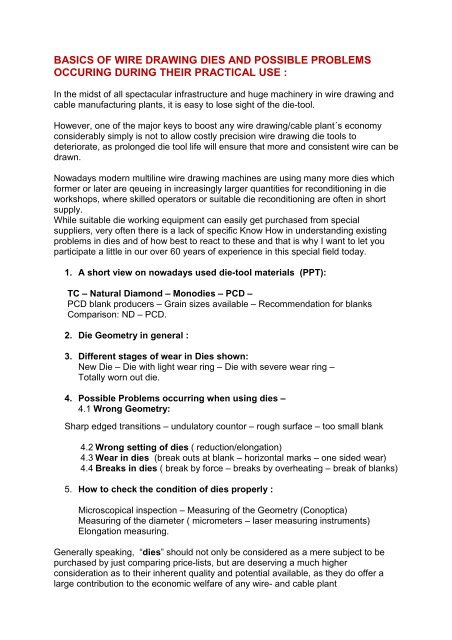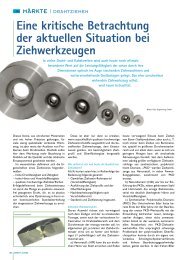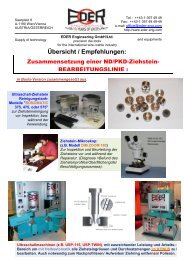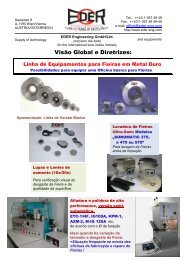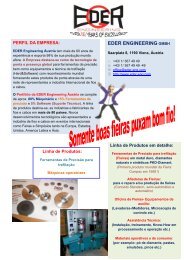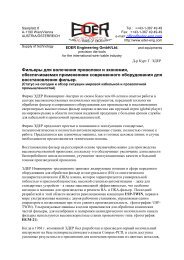Basics of wire drawing (PDF) - Eder Engineering
Basics of wire drawing (PDF) - Eder Engineering
Basics of wire drawing (PDF) - Eder Engineering
You also want an ePaper? Increase the reach of your titles
YUMPU automatically turns print PDFs into web optimized ePapers that Google loves.
BASICS OF WIRE DRAWING DIES AND POSSIBLE PROBLEMS<br />
OCCURING DURING THEIR PRACTICAL USE :<br />
In the midst <strong>of</strong> all spectacular infrastructure and huge machinery in <strong>wire</strong> <strong>drawing</strong> and<br />
cable manufacturing plants, it is easy to lose sight <strong>of</strong> the die-tool.<br />
However, one <strong>of</strong> the major keys to boost any <strong>wire</strong> <strong>drawing</strong>/cable plant´s economy<br />
considerably simply is not to allow costly precision <strong>wire</strong> <strong>drawing</strong> die tools to<br />
deteriorate, as prolonged die tool life will ensure that more and consistent <strong>wire</strong> can be<br />
drawn.<br />
Nowadays modern multiline <strong>wire</strong> <strong>drawing</strong> machines are using many more dies which<br />
former or later are qeueing in increasingly larger quantities for reconditioning in die<br />
workshops, where skilled operators or suitable die reconditioning are <strong>of</strong>ten in short<br />
supply.<br />
While suitable die working equipment can easily get purchased from special<br />
suppliers, very <strong>of</strong>ten there is a lack <strong>of</strong> specific Know How in understanding existing<br />
problems in dies and <strong>of</strong> how best to react to these and that is why I want to let you<br />
participate a little in our over 60 years <strong>of</strong> experience in this special field today.<br />
1. A short view on nowadays used die-tool materials (PPT):<br />
TC – Natural Diamond – Monodies – PCD –<br />
PCD blank producers – Grain sizes available – Recommendation for blanks<br />
Comparison: ND – PCD.<br />
2. Die Geometry in general :<br />
3. Different stages <strong>of</strong> wear in Dies shown:<br />
New Die – Die with light wear ring – Die with severe wear ring –<br />
Totally worn out die.<br />
4. Possible Problems occurring when using dies –<br />
4.1 Wrong Geometry:<br />
Sharp edged transitions – undulatory countor – rough surface – too small blank<br />
4.2 Wrong setting <strong>of</strong> dies ( reduction/elongation)<br />
4.3 Wear in dies (break outs at blank – horizontal marks – one sided wear)<br />
4.4 Breaks in dies ( break by force – breaks by overheating – break <strong>of</strong> blanks)<br />
5. How to check the condition <strong>of</strong> dies properly :<br />
Microscopical inspection – Measuring <strong>of</strong> the Geometry (Conoptica)<br />
Measuring <strong>of</strong> the diameter ( micrometers – laser measuring instruments)<br />
Elongation measuring.<br />
Generally speaking, “dies” should not only be considered as a mere subject to be<br />
purchased by just comparing price-lists, but are deserving a much higher<br />
consideration as to their inherent quality and potential available, as they do <strong>of</strong>fer a<br />
large contribution to the economic welfare <strong>of</strong> any <strong>wire</strong>- and cable plant
When using dies, the easiest way to measure success simply is to look at the<br />
quantity <strong>of</strong> perfectly drawn <strong>wire</strong> achieved by means <strong>of</strong> the relevant die-tool. This<br />
clearly pro<strong>of</strong>s that the best economy to get obtained, mainly is in an optimal increase<br />
<strong>of</strong> the tool life. A prolonged die-life will simply ensure that more <strong>wire</strong> can be drawn.<br />
It also is a proven fact that only well maintained <strong>drawing</strong> die-tools that are kept in top<br />
condition and not allowed to deteriorate, can guarantee an improved die life, larger<br />
quantities <strong>of</strong> high quality <strong>wire</strong> and thus can save considerable money in <strong>wire</strong> mills<br />
and cable plants.<br />
There is therefore ample play for prolonging the service life <strong>of</strong> <strong>wire</strong> <strong>drawing</strong> die-tools<br />
and to boost any plants´ economy considerably, provided that a suitable die<br />
reconditioning workshop equipment and trained, experienced personnel are<br />
available.<br />
EDER-Austria and the Trade House <strong>of</strong> the VNIIKP, as our representation in<br />
Russia, are standing by for any <strong>of</strong> your demands in easy to understand and operate<br />
die working equipment and to assist you too in achieving an optimal economy by<br />
keeping your <strong>wire</strong> <strong>drawing</strong> dies in perfect condition.<br />
Thank you very much for your kind attention and I remain at your entire disposal for<br />
any further questions required.<br />
*<br />
Dr. Kurt G. <strong>Eder</strong>/CEO Drafted in June 08<br />
EDER <strong>Engineering</strong> GmbH<br />
A-1190 Vienna/Austria Brief company information:<br />
Tel: ++43-(0)1-367 49 49 Globally active since 1947 (98% exportation)<br />
Fax: ++43-(0)1-367 49 49-49 Continuously active in the Ex-USSR since 1956<br />
Email: <strong>of</strong>fice@eder-eng.com<br />
Web: http://www.eder-eng.com<br />
Scope <strong>of</strong> production: 10% die-tools, 80 % die working machines, 10% S<strong>of</strong>tware and<br />
projects.


